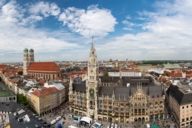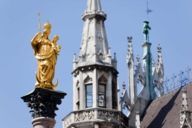
There's always something going on in this world-famous square – whether it's the Christmas market, the city's anniversary celebrations, the Glockenspiel, championship celebrations for FC Bayern or public gatherings for a variety of occasions. Here you can find out everything you need to know about Marienplatz.
- What's on Marienplatz?
- Mariensäule
- FAQ
Marienplatz (square) has been at the centre of the city since Munich was founded by Henry the Lion in 1158. It was the point at which all of the new city’s most important streets met and for centuries it was the centre of Munich's life. And even today, between the Isartor and Karlsplatz-Stachus, Odeonsplatz and Sendlinger Tor, Marienplatz is a popular meeting place, the start of the pedestrian zone and the place from which distances in the city are measured.
These days, you can sit in the shadows of the Neues and Altes Rathaus (New and Old Town Halls) and enjoy a relaxing cup of coffee, watching the hustle and bustle around you. It is also the ideal place to start a tour of the shops in the pedestrian zone or Viktualienmarkt. Popular shopping streets include Kaufingerstrasse, Neuhauser Strasse, Sendlinger Strasse and Theatinerstrasse. In addition, Munich shopping arcades and districts such as the Fünf Höfe are just around the corner. And Maximilianstrasse, the Nationaltheater, the Münchner Kammerspiele, the Residenztheater, the Frauenkirche and the Hofbräuhaus are also within walking distance of Marienplatz.
One of the most popular events at Marienplatz is the Christkindlmarkt. If you want to act like a true native of Munich, arrange to meet up at the Fischbrunnen (fountain) in front of the main entrance to the Neues Rathaus. A must for every visit to Munich is the Glockenspiel in the tower of the New Town Hall, which with its 43 bells is not only one of the largest in Europe, but also one of the most popular sights in the city. Visitors can watch the figures dance daily at 11 am and 12 pm, and between March and October the carillon also takes place at 5 pm.
If you want to see the City Hall balcony, world-famous from the championship celebrations of FC Bayern Munich, or the reading room of the law library, reminiscent of Hogwarts, you can book an exclusive City Hall tour with an official guide of the City of Munich. You can see the Marienplatz and the entire city from above, either from the Alter Peter (church) – Munich's landmark with over 300 steps – or comfortably from the tower of the New Town Hall, which has a lift.
At the centre of Marienplatz, you will find the Mariensäule (column). On top of the column, a golden statue of the Virgin Mary, the Patrona Bavariae, watches over the city and the state of Bavaria. The Mariensäule is the centre of Munich, which is why it is used as a starting point for signposts from other locations to the city. It is also a central point for Catholics: a total of three Popes have visited the column: Pius VI in 1782, Johannes Paul II in 1980 and Benedict XVI in 2006.
Elector Maximilian I had the 11-metre-tall column erected out of Tegernsee marble in 1638. The column was meant to symbolise his gratitude for keeping Munich safe while it was occupied by Sweden during the Thirty Years’ War.

The Renaissance sculptor Hubert Gerhard is rumoured to have created the bronze figurine of the Virgin Mary for the grave of Duke Wilhelm V back in 1593. It adorned the high altar in Munich's Frauenkirche until 1613. Based on the traditional shrine to Mary in Loreto, the Virgin Mary is holding the Baby Jesus and standing atop a moon crescent. The four brave, battling putti on the base of the Mariensäule symbolise Mary's triumph over hunger (the dragon), war (the lion), plague (the basilisk), and heresy (the snake).
Marienplatz has been known by its current name since 9 October 1854 when it was renamed after the Virgin Mary following a cholera epidemic. Before that the square was known as the Schrannenplatz after the South German word for grain on account of the market that used to be held there. The aim of the new name was to bring an end to the outbreak.